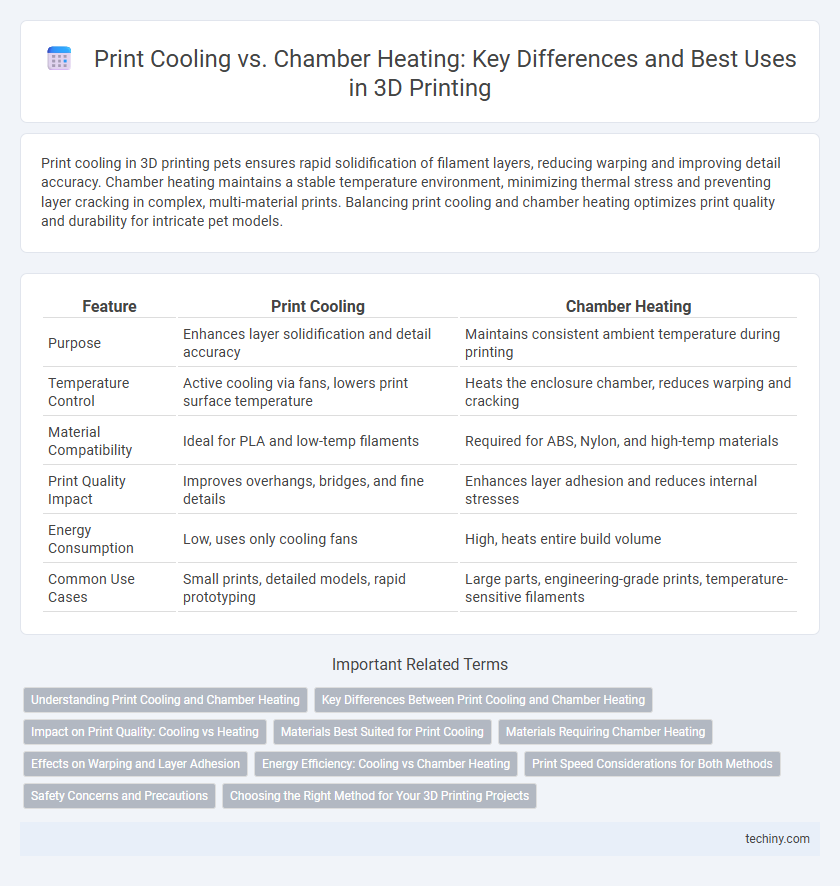Print cooling in 3D printing pets ensures rapid solidification of filament layers, reducing warping and improving detail accuracy. Chamber heating maintains a stable temperature environment, minimizing thermal stress and preventing layer cracking in complex, multi-material prints. Balancing print cooling and chamber heating optimizes print quality and durability for intricate pet models.
Table of Comparison
| Feature | Print Cooling | Chamber Heating |
|---|---|---|
| Purpose | Enhances layer solidification and detail accuracy | Maintains consistent ambient temperature during printing |
| Temperature Control | Active cooling via fans, lowers print surface temperature | Heats the enclosure chamber, reduces warping and cracking |
| Material Compatibility | Ideal for PLA and low-temp filaments | Required for ABS, Nylon, and high-temp materials |
| Print Quality Impact | Improves overhangs, bridges, and fine details | Enhances layer adhesion and reduces internal stresses |
| Energy Consumption | Low, uses only cooling fans | High, heats entire build volume |
| Common Use Cases | Small prints, detailed models, rapid prototyping | Large parts, engineering-grade prints, temperature-sensitive filaments |
Understanding Print Cooling and Chamber Heating
Print cooling in 3D printing involves actively reducing the temperature of the printed layers using fans or directed air to solidify materials quickly and prevent warping, particularly with PLA. Chamber heating maintains a consistent, elevated ambient temperature around the print to reduce thermal stress and minimize layer delamination, especially important for ABS and other high-temperature filaments. Understanding the balance between print cooling and chamber heating is crucial to optimizing layer adhesion, print quality, and minimizing defects in various materials.
Key Differences Between Print Cooling and Chamber Heating
Print cooling in 3D printing rapidly reduces the temperature of the extruded filament to enhance layer adhesion and detail accuracy, while chamber heating maintains a consistent ambient temperature to reduce warping and improve overall print stability. Cooling is vital for materials that require quick solidification like PLA, whereas chamber heating is essential for high-temperature materials such as ABS and nylon to prevent thermal stresses. The key difference lies in their temperature management focus: print cooling targets the filament for precision, whereas chamber heating focuses on the environment for dimensional consistency.
Impact on Print Quality: Cooling vs Heating
Effective print cooling enhances layer adhesion and detail sharpness by rapidly solidifying filament, reducing stringing and warping in PLA and similar materials. In contrast, chamber heating stabilizes the environmental temperature, minimizing thermal stress and cracking in ABS and nylon, leading to improved dimensional accuracy and mechanical strength. Balancing cooling and heating strategies based on filament type and print geometry is crucial for optimizing overall print quality and structural integrity.
Materials Best Suited for Print Cooling
Print cooling is essential for materials like PLA and PETG, which benefit from rapid solidification to maintain dimensional accuracy and surface quality. These thermoplastics exhibit optimal layer adhesion and reduced stringing when cooled effectively during printing. In contrast, materials such as ABS and nylon require slower cooling, making chamber heating more suitable to prevent warping and ensure structural integrity.
Materials Requiring Chamber Heating
Materials like ABS, polycarbonate, and certain high-performance composites require chamber heating to prevent warping and improve layer adhesion during 3D printing. Maintaining a heated chamber environment minimizes thermal gradients, reducing internal stresses and enhancing overall print quality. Print cooling must be carefully managed or reduced for these materials to avoid cracking and ensure dimensional stability.
Effects on Warping and Layer Adhesion
Print cooling and chamber heating critically influence warping and layer adhesion in 3D printing. Effective print cooling solidifies layers quickly, reducing deformation but may weaken interlayer bonding, while chamber heating maintains consistent ambient temperature, minimizing thermal gradients that cause warping and improving layer fusion. Optimizing the balance between cooling intensity and chamber temperature enhances dimensional accuracy and structural integrity in printed parts.
Energy Efficiency: Cooling vs Chamber Heating
Print cooling in 3D printing uses targeted fans to quickly solidify layers, resulting in lower energy consumption compared to maintaining a uniformly heated chamber. Chamber heating requires continuous energy input to keep the entire build volume at a stable temperature, which can lead to higher power usage and increased operational costs. Optimizing print cooling accelerates print speed and improves dimensional accuracy while minimizing electricity usage, enhancing overall energy efficiency.
Print Speed Considerations for Both Methods
Print cooling enhances layer solidification rates, allowing for faster print speeds by reducing the risk of warping and stringing in PLA and similar materials. Chamber heating stabilizes ambient temperatures, improving adhesion and reducing internal stresses, which benefits slower, high-precision prints with ABS or Nylon. Balancing print cooling and chamber heating is essential for optimizing speed while maintaining print quality across diverse filament types.
Safety Concerns and Precautions
Print cooling systems reduce overheating risks by regulating extrusion temperature, preventing nozzle jams and ensuring part integrity. Chamber heating maintains consistent environmental temperature to minimize warping and layer separation but requires careful monitoring to avoid fire hazards and thermal damage to printer components. Implementing thermal sensors and automatic shutoff mechanisms enhances safety by detecting abnormal heat levels and preventing potential accidents.
Choosing the Right Method for Your 3D Printing Projects
Print cooling is ideal for materials like PLA that require rapid solidification to maintain detail and prevent warping, enhancing layer adhesion and surface finish. Chamber heating benefits ABS and nylon by maintaining a consistent ambient temperature, reducing internal stresses and minimizing warping or cracking during the printing process. Selecting the right method depends on the filament type and part geometry, ensuring optimal mechanical properties and dimensional accuracy for your 3D printed projects.
Print Cooling vs Chamber Heating Infographic

 techiny.com
techiny.com